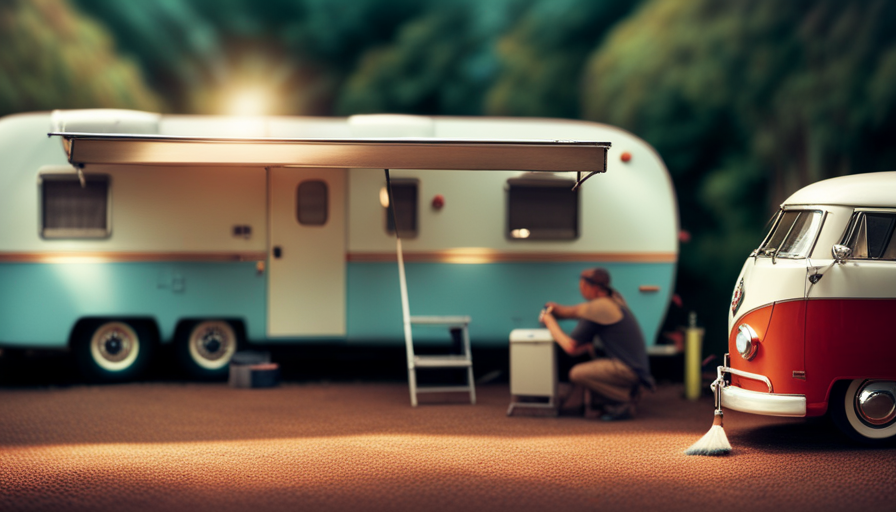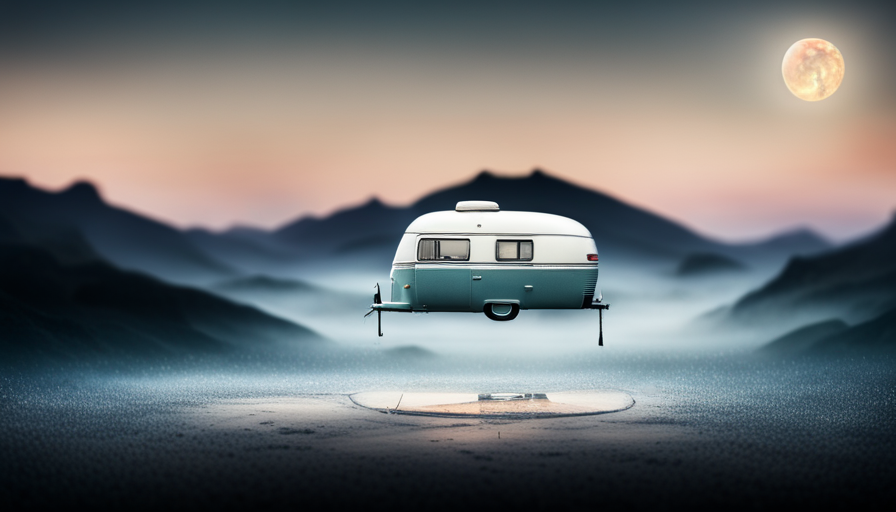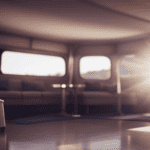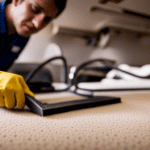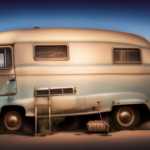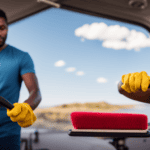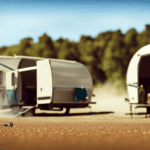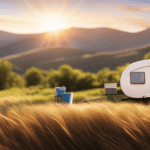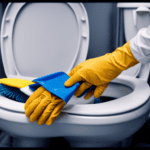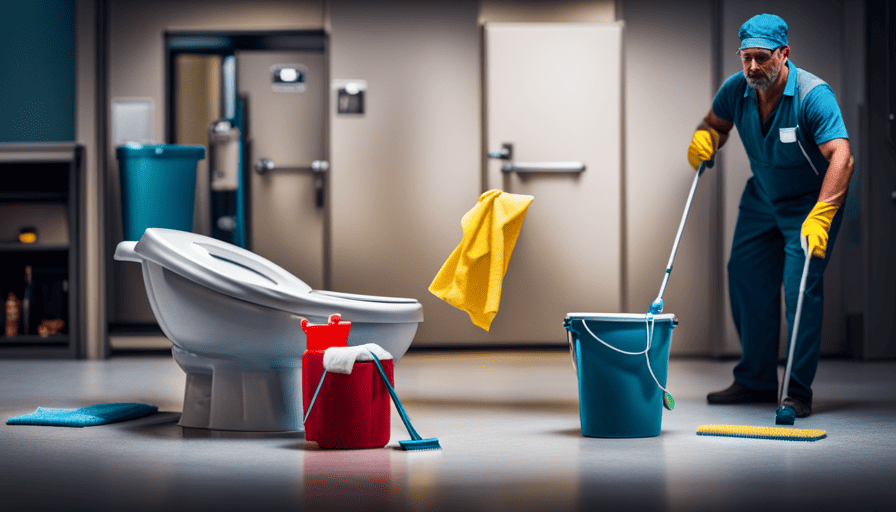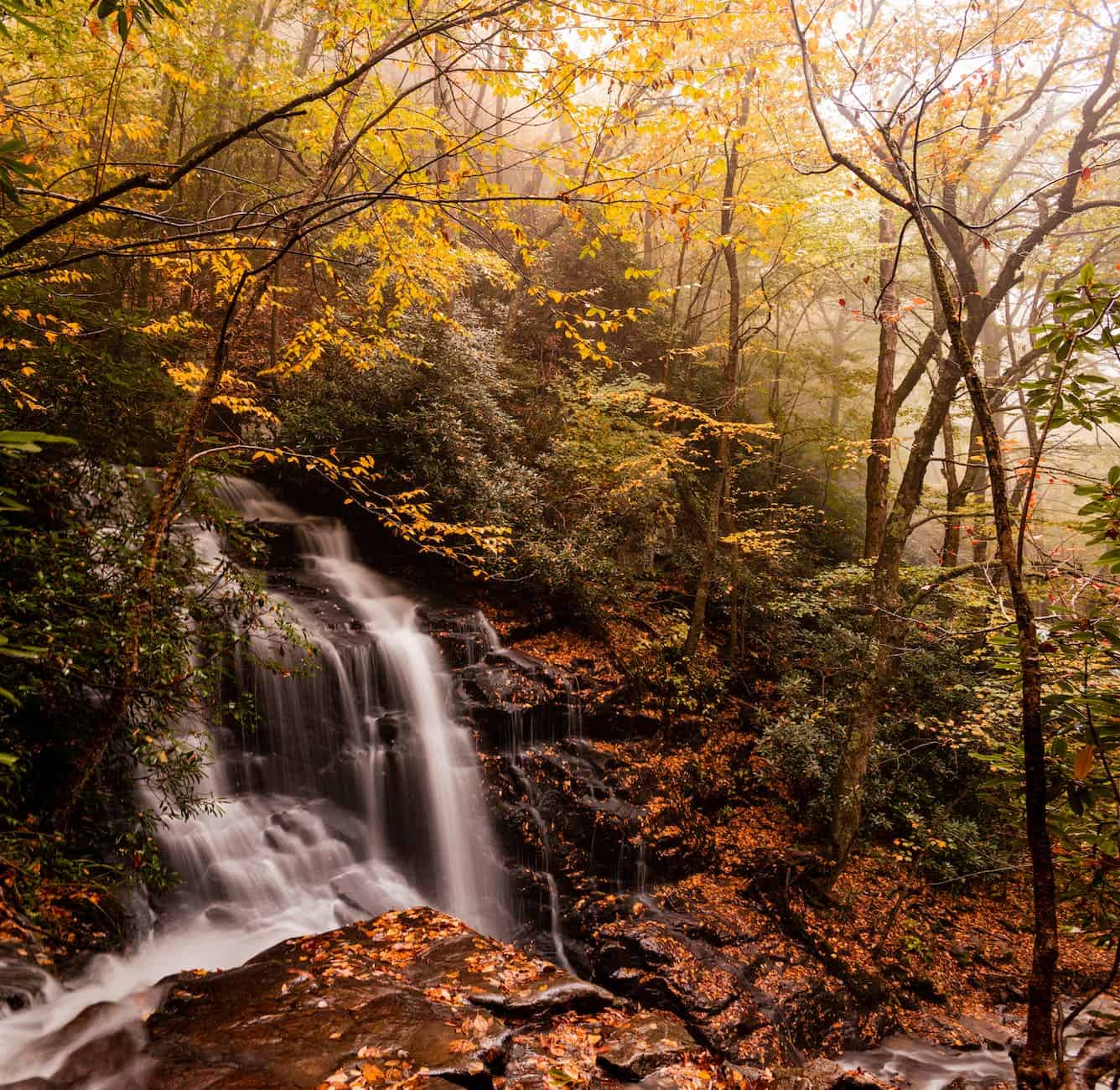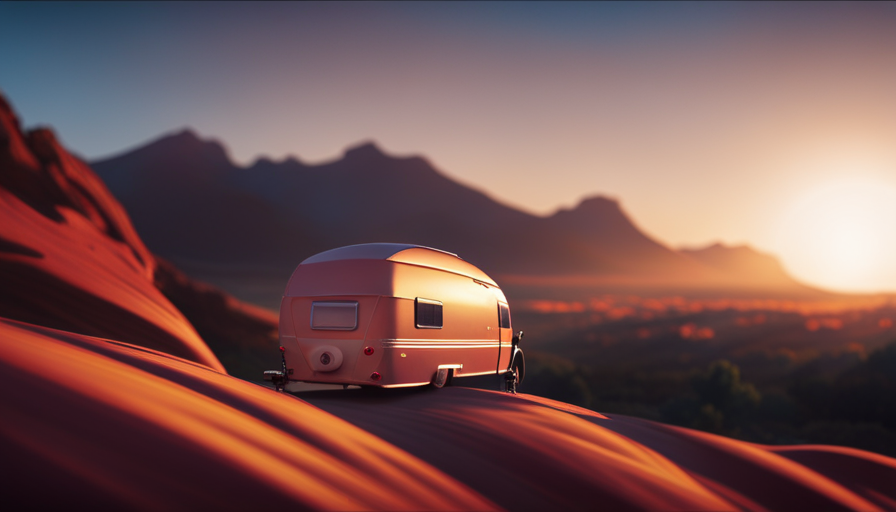Are you exhausted from walking into your camper and being greeted by a mess of dirt and filth? Don’t worry, because we’ve got the ultimate guide on how to clean a camper! Prepare to turn your cherished mobile home into a pristine oasis that you’ll want to flaunt to your loved ones.
Cleaning a camper may seem like a daunting task, but with our expert tips and tricks, you’ll be able to tackle it with ease. From the exterior to the interior, we’ll show you how to get every nook and cranny sparkling clean. We’ll even give you advice on how to maintain your camper’s cleanliness so it stays fresh and inviting all year round.
So grab your cleaning supplies and let’s get started on this camper cleaning adventure. Prepare to be amazed at the results as we guide you through the best practices for cleaning your camper. Get ready to enjoy a clean and fresh camper that’s ready for your next adventure!
Key Takeaways
- Gather all necessary cleaning supplies before starting to ensure a thorough cleaning process.
- Use specialized camper wash and wax products for the exterior cleaning to maintain its longevity.
- Pay attention to hard-to-reach areas and overhead surfaces, using extendable dusters for effective cleaning.
- Clean and declutter the interior, including appliances, furniture, and upholstery, to create a cozy and organized space.
Gather Your Cleaning Supplies
Before you start cleaning your camper, gather all of your supplies in one central location, including your cleaning solution, microfiber cloths, a vacuum cleaner, and a broom and dustpan. Having a cleaning checklist can help ensure that you have all the essential cleaning supplies you need. This will save you time and effort later on.
Start by gathering your cleaning solution. Look for a cleaner that’s specifically formulated for campers, as it’ll be effective in removing dirt and grime without damaging the surfaces. Microfiber cloths are a must-have for cleaning the interior of your camper. They’re gentle on surfaces and can easily pick up dust and dirt.
Next, grab your trusty vacuum cleaner. This’ll be essential for cleaning the floors, upholstery, and any nooks and crannies where dirt tends to accumulate. A broom and dustpan are also handy for sweeping away any loose dirt or debris before you start vacuuming.
Now that you have all your supplies ready, it’s time to tackle the cleaning process. Start with the exterior, giving it a thorough wash to remove any dirt or stains.
Transitioning into the subsequent section, we’ll move on to cleaning the interior of the camper.
Start with the Exterior
First, you’ll want to give the exterior of your camper a thorough scrub to ensure a sparkling finish that will make it stand out on the road. When it comes to exterior cleaning techniques, there are a few key steps to follow.
Start by rinsing the camper with a hose to remove any loose dirt and debris. Next, use a soft-bristle brush or sponge and a mild detergent to gently scrub the exterior surfaces. Be sure to pay extra attention to areas that tend to accumulate dirt, such as the wheels, windows, and awning.
Rinse off the soap with clean water and use a microfiber cloth to dry the camper, preventing water spots.
To achieve the best results, it’s essential to use the right cleaning products for campers. Look for a specialized camper wash and wax product that is safe for the exterior materials of your camper. These products are designed to remove tough stains, protect against UV damage, and leave a protective layer that enhances the shine. Additionally, consider using a rubber roof cleaner and protectant to keep your camper’s roof in top condition.
Now that the exterior is spotless and gleaming, it’s time to turn our attention to the interior.
Clean the Interior
When it comes to cleaning the interior of a camper, there are a few key points to keep in mind.
First and foremost, vacuuming and dusting the entire space is essential to remove any dirt or debris that may have accumulated.
Next, wiping down surfaces such as countertops, tables, and windows will help to maintain a clean and fresh environment.
Lastly, don’t forget to thoroughly clean the kitchen and bathroom areas, ensuring that they’re sanitary and ready for use.
By following these steps, you can keep your camper looking and feeling its best.
Vacuum and Dust
To tackle the task of vacuuming and dusting your camper like a pro, grab that trusty vacuum cleaner and banish those pesky particles in a jiffy.
When it comes to vacuuming techniques, start by removing any loose items from the floor and then work your way from top to bottom, making sure to reach all the nooks and crannies. Use the various attachments that come with your vacuum to effectively clean upholstery, carpets, and hard-to-reach places.
For the dusting part, equip yourself with the right tools such as microfiber cloths or electrostatic dusters. These tools are great at capturing dust without spreading it around. Remember to dust all surfaces, including shelves, countertops, and electronics.
Once you’ve vacuumed and dusted, you can transition into the subsequent section about wiping down surfaces to complete the cleaning process.
Wipe Down Surfaces
Now that you’ve banished the pesky particles with your trusty vacuum cleaner, it’s time to move on to the next step: wiping down surfaces. This is an essential part of keeping your camper clean and maintaining a healthy environment.
Here are three important things to consider when wiping down surfaces in your camper:
-
Use eco-friendly cleaning products: It’s crucial to choose cleaning products that are safe for both you and the environment. Look for eco-friendly options that are free from harsh chemicals and toxins. Not only will this help protect your health, but it’ll also minimize the impact on the ecosystem.
-
Cleaning hard to reach areas: Cleaning every nook and cranny in your camper can be challenging. To tackle hard to reach areas, use a microfiber cloth or a small brush to ensure thorough cleaning. Pay special attention to corners, crevices, and tight spaces where dirt and dust tend to accumulate.
-
Don’t forget about the overhead surfaces: When wiping down surfaces, it’s easy to overlook the overhead areas. Dust and dirt can gather on the ceilings, cabinets, and light fixtures. Use an extendable duster or a microfiber mop to clean these areas effectively.
Now, let’s transition into the next section where we discuss how to clean the kitchen and bathroom in your camper.
Clean the Kitchen and Bathroom
Make sure your kitchen and bathroom sparkle with cleanliness to create a refreshing and inviting space. When it comes to cleaning the kitchen and bathroom in your camper, there are a few cleaning tips and deep cleaning techniques that can help you achieve a spotless result.
Start by removing all items from the kitchen and bathroom surfaces, such as dishes, toiletries, and towels. Then, wipe down the countertops, sinks, and faucets using a mild cleaner and a microfiber cloth. Pay attention to any stains or grime, and scrub them away using a soft-bristled brush or sponge.
For the bathroom, don’t forget to clean the toilet, shower, and mirror as well. Once everything is clean and shiny, it’s time to move on to the next section about paying attention to the floors.
Pay Attention to the Floors
Start by giving the floors of your camper a thorough sweep to remove any dirt and debris. Paying attention to the floors is essential for maintaining a clean and comfortable living space. Here are some cleanliness tips to keep in mind:
-
Vacuum the floors: Use a handheld vacuum or a small broom to gather up any remaining dust and particles. This will help prevent dirt from being tracked throughout the camper.
-
Spot clean stains: If you notice any stains or spills on the floor, address them immediately. Use a mild detergent or carpet cleaner to spot clean the affected area.
-
Use a steam cleaner: For a deep clean, consider using a steam cleaner on your carpets and rugs. This will help remove embedded dirt and odors, leaving your floors fresh and sanitized.
-
Don’t forget the corners: Pay extra attention to the corners of the floor, as dirt and dust tend to accumulate there. Use a small brush or a crevice tool to reach those hard-to-reach areas.
-
Dry thoroughly: After cleaning, make sure the floors are completely dry to prevent any moisture-related issues, such as mold or mildew.
Now that the floors are spotless, let’s move on to the next section about not forgetting the upholstery.
Don’t Forget the Upholstery
Take a moment to give your upholstered furniture some attention, as it plays a vital role in creating a cozy and inviting atmosphere inside your camper. Upholstery cleaning is an essential part of maintaining a clean and fresh interior. To keep your upholstery looking its best, follow these upholstery cleaning tips.
Firstly, it’s important to choose the right cleaning products for your specific upholstery material. Different fabrics require different cleaning methods, so be sure to read the manufacturer’s instructions or consult a professional if you’re unsure. Avoid using harsh chemicals that could damage or discolor the fabric.
Before applying any cleaning product, it’s a good idea to vacuum the upholstery to remove any loose dirt and debris. This will make the cleaning process more effective and prevent dirt from being pushed further into the fabric.
When applying the cleaning product, always test it on a small, inconspicuous area first to ensure it doesn’t cause any discoloration or damage. Once you’re confident it’s safe to use, follow the instructions on the product and gently clean the upholstery using a soft cloth or brush.
After cleaning, allow the upholstery to dry completely before using the furniture again. This will prevent any moisture from causing mold or mildew.
Now that your upholstery is looking fresh and clean, it’s time to move on to the next step: cleaning the appliances.
Clean the Appliances
Now that you’ve given your upholstery some attention, it’s time to tackle the appliances and get them sparkling clean. Cleaning appliances in a camper is crucial to maintain their functionality and ensure a pleasant camping experience.
Here are three essential steps to follow in order to effectively clean your camper’s appliances:
-
Start by wiping down all surfaces with a damp cloth and a gentle cleaning solution. This will remove any dirt or grime that’s accumulated over time.
-
Pay special attention to the stove and oven. Use a non-abrasive cleaner to remove any grease or stains. Scrub the burners and grates to make sure they’re spotless.
-
Don’t forget about the refrigerator. Empty it completely and wipe down all shelves and drawers with a mixture of water and vinegar to eliminate any odors. Be sure to remove any spills or stains.
By thoroughly cleaning your camper’s appliances, you not only maintain their appearance but also prevent any potential issues that may arise from neglect.
Now that your appliances are gleaming, it’s time to move on to the next step of the cleaning process: organizing and decluttering your camper.
Organize and Declutter
To optimize your camping experience, it’s imperative that you efficiently organize and declutter your camper. Decluttering is essential to create a clean and spacious environment that’ll make your camping trip more enjoyable. Here are some decluttering tips and storage solutions that’ll help you keep your camper neat and tidy.
Firstly, start by sorting through all your belongings and getting rid of anything you don’t need or use anymore. This’ll free up space and make it easier to organize the remaining items. Utilize storage bins and containers to keep similar items together and maximize storage space. Install hooks and racks on the walls to hang jackets, hats, and other accessories.
Another useful tip is to make use of vertical space. Install shelves or hanging organizers inside cabinets and closets to take advantage of the available space. This’ll help prevent items from getting lost or misplaced. Additionally, consider using collapsible furniture and stackable storage solutions to save space when not in use.
Efficiently organizing and decluttering your camper is crucial for a successful camping trip. By following these decluttering tips and storage solutions, you can create a clean and organized space that’ll enhance your camping experience.
Next, let’s explore how to freshen up the air in your camper without using harsh chemicals.
Freshen Up the Air
When it comes to freshening up the air in a camper, there are a few key points to keep in mind. First, using air fresheners or deodorizers can really make a difference in eliminating lingering odors.
Second, opening windows and ventilating the space can help circulate fresh air and remove any stale smells.
Lastly, it’s important to be knowledgeable and detail-oriented when freshening up the air, as a clean and fresh-smelling camper can greatly enhance the overall camping experience.
Use Air Fresheners or Deodorizers
Freshen up your camper by using air fresheners or deodorizers, which can eliminate up to 99% of unpleasant odors, transforming your space into a fragrant haven.
When deciding between air fresheners and deodorizers, it’s important to understand their differences. Air fresheners simply mask odors by releasing a pleasant scent, while deodorizers work by neutralizing and eliminating the source of the odor. In a camper, where space is limited, it’s best to use deodorizers as they provide a more effective and long-lasting solution.
Consider using charcoal-based deodorizers, which naturally absorb and eliminate odors, or enzymatic deodorizers that break down odor-causing molecules. By using deodorizers, you can ensure a fresh and odor-free environment for your camping adventures.
Now, let’s move on to the next step: opening windows and ventilating the camper.
Open Windows and Ventilate
Ensure a fresh and odor-free environment in your camper by opening windows and ventilating regularly. By opening windows, you allow fresh air to circulate throughout the space and eliminate any lingering smells. This simple step can make a world of difference in creating a pleasant atmosphere inside your camper.
Not only does fresh air help to remove odors, but it also helps to reduce humidity and prevent the growth of mold and mildew. It’s important to open windows and ventilate your camper after cooking, using the bathroom, or whenever you notice any stale or unpleasant smells. By incorporating this practice into your regular cleaning routine, you can maintain a clean and inviting environment for your camping adventures.
Maintain Regular Cleaning
To keep your camper looking its best, make sure you regularly clean it, using a mix of gentle cleaners and a soft cloth, to maintain its shine and allure.
Regular cleaning has a multitude of benefits for your camper. Not only does it enhance its appearance, but it also helps to prevent the buildup of dirt, grime, and stains that can be difficult to remove if left unattended for long periods. By establishing a cleaning schedule, you can ensure that your camper stays in top condition year-round.
We recommend cleaning the interior and exterior at least once a month, or more frequently if you frequently use your camper or if it’s exposed to harsh weather conditions.
When cleaning the interior, start by removing any clutter and dusting all surfaces. Vacuum the floors and upholstery to eliminate any dirt or debris.
For the exterior, use a mild detergent and warm water to gently clean the surfaces, taking care to avoid abrasive cleaners that can damage the camper’s finish. Finish off by drying the camper thoroughly with a soft cloth to prevent water spots. When cleaning the interior of the camper, sweep or vacuum the floors and wipe down any surfaces with a damp cloth. Be sure to check for any mold or mildew and address it promptly. When it comes to cleaning pop up camper canvas, use a solution of mild soap and water, and gently scrub with a soft brush. Avoid using harsh chemicals or bleach, as this can damage the fabric. Be sure to allow the canvas to fully dry before putting the camper away to prevent mildew growth. For the interior, a vacuum and gentle upholstery cleaner can be used to clean the upholstery and flooring. Be sure to test any new cleaning products on a small, inconspicuous area first to ensure they won’t damage the material. Additionally, for canvas cleaning tips, gently brush any dirt or debris off of the canvas surfaces before using a mild soap and water to clean. Allow the canvas to air dry completely before rolling it back up to prevent mold or mildew.
By maintaining a regular cleaning routine, you can enjoy your clean and fresh camper!
Enjoy Your Clean and Fresh Camper!
Now that your camper is sparkling and pristine, take a moment to revel in the rejuvenating feeling of a well-maintained home away from home.
Maintaining a clean camper not only enhances your camping experience but also offers several benefits.
Firstly, a clean camper promotes a healthier environment. By regularly cleaning and sanitizing surfaces, you can prevent the buildup of bacteria and allergens, reducing the risk of illnesses and allergies. This is especially important if you have young children or individuals with respiratory conditions.
Secondly, a clean camper helps to preserve its value. Regular cleaning prevents dirt, dust, and grime from accumulating, which can lead to damage over time. By taking care of your camper’s interior and exterior, you are ensuring that it remains in optimal condition, increasing its longevity and potential resale value.
Additionally, a clean camper creates a more enjoyable and inviting space. When everything is tidy and organized, it is easier to relax and unwind after a day of outdoor adventures. You can fully immerse yourself in the beauty of nature without the distraction of clutter or mess.
Maintaining a clean camper has numerous benefits. It promotes a healthier environment, preserves the value of your camper, and enhances your overall camping experience. So, embrace the joy of a clean and fresh camper and make the most out of your home away from home.
Frequently Asked Questions
How often should I clean my camper?
We recommend cleaning your camper regularly to maintain its appearance and prevent damage. When it comes to the exterior, it’s important to clean it without damaging the paint. To achieve this, use a gentle soap and warm water, and avoid abrasive cleaning tools.
If you’re unsure about cleaning the camper yourself, hiring a professional can ensure a thorough and safe cleaning process. Remember, regular cleaning will help prolong the life of your camper and keep it looking its best.
Can I use regular household cleaning products on the exterior of my camper?
Yes, you can use regular household cleaning products on the exterior of your camper. However, it’s important to choose products that are suitable for the surface materials of your camper, such as fiberglass or aluminum.
Additionally, consider using eco-friendly options to minimize environmental impact. When using cleaning techniques, make sure to follow the manufacturer’s instructions and test the product on a small, inconspicuous area first. Always rinse thoroughly to remove any residue.
Is it necessary to clean the appliances in my camper regularly?
Regularly cleaning and maintaining the appliances in your camper is crucial for their longevity and optimal performance. It is especially important to pay attention to the plumbing system, as any issues can lead to costly repairs and inconveniences.
To keep the plumbing system in good shape, regularly flush it with clean water and use RV-specific cleaning products. Additionally, when it comes to the awning, make sure to clean it regularly and avoid using harsh chemicals that could damage the fabric.
Proper maintenance of these components ensures a smooth and enjoyable camping experience.
How can I remove stubborn stains from the upholstery in my camper?
To remove stubborn stains from camper upholstery, the best cleaning method is to start by identifying the type of stain. For food or drink spills, blot the area with a mixture of water and mild detergent.
For oil-based stains, apply a small amount of dish soap and gently scrub with a soft brush.
For more challenging stains, try using a stain remover specifically designed for upholstery.
Always test any cleaning solution on a small, inconspicuous area first to avoid damaging the fabric.
Are there any specific cleaning products that are recommended for freshening up the air inside a camper?
When it comes to freshening up the air inside a camper, there are some great options to consider. The best air fresheners for campers are those that are specifically designed to eliminate odors in small spaces. Look for products that aren’t only effective but also long-lasting.
Some popular choices include odor-eliminating sprays, air purifiers, and scented sachets. These can help remove unpleasant smells and create a more pleasant and inviting environment inside your camper.
Conclusion
In conclusion, cleaning a camper doesn’t have to be a daunting task. By following the steps outlined in this article, we can keep our campers clean, fresh, and ready for our next adventure.
One interesting statistic to note is that regular cleaning can prevent the buildup of mold and mildew, which can lead to potential health issues. So, let’s take the time to maintain our campers, ensuring a safe and enjoyable experience for everyone. Happy camping!

